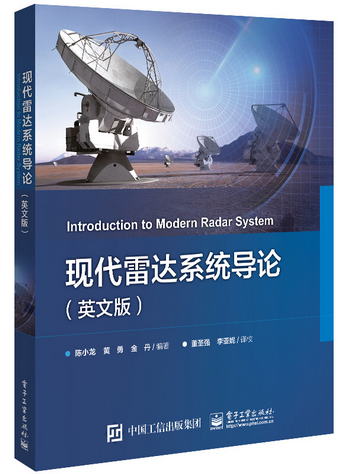| | | | 現代雷達繫統導論(英文版) | | 該商品所屬分類:圖書 -> 電子工業出版社 | | 【市場價】 | 617-896元 | | 【優惠價】 | 386-560元 | | 【作者】 | 陳小龍 | | 【所屬類別】 | 電子工業出版社 | | 【出版社】 | 電子工業出版社 | | 【ISBN】 | 9787121357770 | | 【折扣說明】 | 一次購物滿999元台幣免運費+贈品
一次購物滿2000元台幣95折+免運費+贈品
一次購物滿3000元台幣92折+免運費+贈品
一次購物滿4000元台幣88折+免運費+贈品
| | 【本期贈品】 | ①優質無紡布環保袋,做工棒!②品牌簽字筆 ③品牌手帕紙巾
|
|
| 版本 | 正版全新電子版PDF檔 | | 您已选择: | 正版全新 | 溫馨提示:如果有多種選項,請先選擇再點擊加入購物車。*. 電子圖書價格是0.69折,例如了得網價格是100元,電子書pdf的價格則是69元。
*. 購買電子書不支持貨到付款,購買時選擇atm或者超商、PayPal付款。付款後1-24小時內通過郵件傳輸給您。
*. 如果收到的電子書不滿意,可以聯絡我們退款。謝謝。 | | | |
| | 內容介紹 | |

出版社:電子工業出版社 ISBN:9787121357770 版次:1 商品編碼:13377860 品牌:電子工業出版社 包裝:平裝 開本:16開 出版時間:2021-08-01 用紙:膠版紙 頁數:268 正文語種:外文 作者:陳小龍
" 內容簡介 本書繫統地論述了現代雷達的構成、功能、信號和數據處理及應用,內容包括雷達的基本原理、功能、繫統組成和性能指標,雷達天線,雷達發射機,雷達接收機,雷達顯示和回波,雷達測量,雷達檢測距離,雷達目標檢測和跟蹤,相干雷達信號處理,電子戰術語與概念,雷達新技術和新體制等。全書內容全面,論述簡明,由淺入深,注重基本原理與實際應用的聯繫。本書可作為信息與通信工程專業或雷達專業高年級本科生的課外輔導用書,也可作為雷達外訓任務的教材,還可作為科技工作者和工程技術人員的參考書籍。 作者簡介 陳小龍,山東煙臺人,長期從事雷達原理及弱小目標檢測等方面的教學與科研工作。主講“機載雷達技術”“雷達信號理論”“現代雷達原理”(英文)等課程。發表論文90餘篇,授權發明專利20餘項。主編教材2部,國家科技出版基金資助專著1部。獲省部級獎勵4項。中國科協青托、中國電子學會優秀科技工作者。《雷達學報》、《太赫茲科學與電子信息學報》編委。 目錄 Contents
Chapter 1 An Introduction to Radar 1
1.1 Fundamental Elements of Radar 2
1.1.1 The Radar Concept 2
1.1.2 Types of Radar 5
1.1.3 Radar Medium 9
1.2 A Brief History of the Evolution of Radar 9
1.2.1 Early Experiments 9
1.2.2 First Military Radars 10
1.3 Functions Performed by Radar 12
1.3.1 Overall System Considerations 12
1.3.2 Basic Radar Functions 14
1.4 Radar Frequency 16
1.4.1 Radar Frequency Division 16
1.4.2 Influence of Frequency on Radar Performance 19
1.5 Some Definitions and Other Details 22
1.5.1 Types of Radar Targets 22
1.5.2 Target Fluctuation Models 23
1.5.3 Noise, Signal-to-Noise Ratio, and Detection 24
Chapter 2 Radar Antenna 27
2.1 Distribution of Radiated Energy in Angle 29
2.2 Types of Radar Antennas 34
2.2.1 Yagi Antennas 34
2.2.2 Reflector Antennas 36
2.2.3 Phased Array Antennas 40
2.3 Characteristics of the Radiation Pattern 45
2.4 Phase Scanning 51
Summary 55
Chapter 3 Radar Transmitter 57
3.1 Requirements for Transmitters 57
3.2 Summary of Radar RF Power Sources 58
3.2.1 Oscillator 61
3.2.2 Tube Amplifiers 63
3.2.3 Solid-State RF Power Sources 66
3.3 Two Basic Transmitter Configurations 68
3.3.1 Self-excited Oscillator 68
3.3.2 Power Oscillator 68
3.3.3 The Pulse Modulator 70
3.4 Pulsed Waveform 72
3.5 Coherent Radar 83
3.5.1 Concept of Coherence 83
3.5.2 Fully Coherent Radar 84
3.5.3 Solid-State Amplifier 87
Summary 88
Chapter 4 Radar Receiver 90
4.1 Summary of Receiver Types 91
4.1.1 Crystal Video Receiver 92
4.1.2 Homodyne Receivers 93
4.1.3 Superheterodyne Receivers 94
4.2 Major Receiver Functions 99
4.2.1 Receiver Protection 99
4.2.2 RF Preselection 100
4.2.3 Frequency Downconversion and Mixers 101
4.2.4 Selection of LO and IF Frequencies 102
4.3 Electrical Background Noise 103
4.4 Receiver Dynamic Range 108
4.4.1 Sensitivity Time Control (STC) 110
4.4.2 Gain Control 111
Summary 112
Chapter 5 Radar Display and Returns 113
5.1 Radar Displays 114
5.2 Radar Clutter 118
5.2.1 Introduction to Radar Clutter 118
5.2.2 General Dependencies of Surface Clutter 121
5.2.3 Sea Clutter 122
Chapter 6 Radar Measurements 127
6.1 Range Measurements 128
6.1.1 Pulse Ranging Method 128
6.1.2 Minimum Range 128
6.1.3 Maximum Range 129
6.1.4 Range Resolution 130
6.1.5 Pulse Compression 132
6.2 Direction Measurements 136
6.2.1 Lobing Angle Measurement 137
6.2.2 Monopulse Angle Measurement 138
6.3 Velocity Measurements 143
6.3.1 Doppler Effect 143
6.3.2 Doppler Shift 144
6.3.3 Unambiguous Doppler Shift Measurement 147
Summary 148
Chapter 7 The Radar Detection Range 150
7.1 What Determines Detection Range 151
7.2 Radar Range Equation 154
7.2.1 Power Density at a Distance R 154
7.2.2 Received Power from a Target 155
7.2.3 Signal-to-Noise Ratio and the Radar Range Equation 157
7.2.4 Summary of Losses 158
7.2.5 Solving For Other Variables 159
7.2.6 Decibel Form of the Radar Range Equation 159
7.2.7 Radar Line of Sight (RLOS) 161
7.2.8 Radar Reflections from Flat Ground 162
7.2.9 The Radar Equation in Practice 163
7.3 What the Range Equation Tells Us 165
7.4 Surface Clutter Radar Equation 169
Summary 171
Chapter 8 Fundamental of Radar Detection and Tracking 173
8.1 Detection Process 173
8.2 Integration and Its Leverage on Detection Range 177
8.2.1 Integration Experiment 177
8.2.2 Multiple-Pulse Effects on Radar Equation 181
8.3 Parameters of Radar Detection 183
8.3.1 Detection Probability 183
8.3.2 False-Alarm Rate 184
8.3.3 Detection Threshold 185
8.3.4 Signal-to-Noise Ratio 187
8.4 Constant False Alarm Rate Detector 189
8.4.1 Basic CFAR Architecture 190
8.4.2 Cell Averaging CFAR 192
8.5 Tracking with Radar 195
8.5.1 Types of Tracking 195
8.5.2 Radar Range Tracking 197
8.6 Radar Signal Management 201
Summary 203
Chapter 9 Coherent Radar Signal Processing 204
9.1 Pulsed Radar Doppler Data Acquisition and Characteristics 206
9.2 Moving Target Indication (MTI) 208
9.2.1 Basic Principle 208
9.2.2 Pulse Cancellers 210
9.2.3 Blind Speeds 212
9.2.4 Merits and Limitations 213
9.3 Pulse-Doppler Processing 215
9.3.1 Basic Principle 215
9.3.2 Doppler Filter Bank 217
9.3.3 Metrics for Pulse-Doppler Detection of Moving Targets 219
9.3.4 The Moving Target Detector (MTD) 221
Summary 225
Chapter 10 Electronic Warfare Terms and Concepts 226
10.1 EW Definition 226
10.2 EW Subfields 226
10.3 Electronic Warfare Support 227
10.4 Electronic Attack 233
10.5 Electronic Protection 240
Summary 242
Chapter 11 New Technology and System of Radar 243
11.1 Low Probability of Intercept (LPI) Radar 243
11.2 Multifunction Rotating Electronically Scanned Radars 245
11.3 Ultra Wide-Band (UWB) Radar 246
11.4 Noise Radar Technology 247
11.5 Multi-Input Multi-Output (MIMO) Radar 248
11.6 Synthetic Aperture Radar (SAR) 249
11.7 Air-Defense Radars 251
11.8 Ground Penetrating Radar (GPR) 252
Reference 256 查看全部↓
" | | |
| | | | |
|




